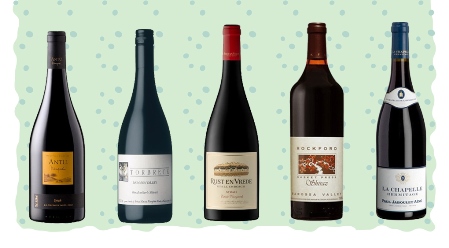We’re showcasing the Syrah or Shiraz grape this week. Both terminology refer to the same genetic grape – generallly speaking Syrah represents the old-worldstyle – leaner and more terroir driven (aka Northern Rhone), while Shiraz is more fruit forward, new-world in style (aka Australian Barossa Valley). Genetic profiling In 1998 established that the variety’s parents are in fact the obscure Mondeuse blanche and Dureza grapes, believed to be local to the Rhône-Alpes region of France. Some studies also show that, with great probability, Pinot Noir is the great-grandparent of Syrah/Shiraz, and both Viognier and Mondeuse Noire seem to be closely related to Syrah, too – the lines are pretty blurry.
Syrah/Shiraz can produce wines of great elegance that can age beautifully. Some of its distinct characteristics are intense black fruit aromas lined by a savory tapenade-like edge, medium to high tannins and black/white pepper spice. (Syrah/Shiraz is one of the varieties shown to contain more of a compound called rotundone, responsible for peppery aromas in wine.
Unlike other varieties, Syrah demonstrates a strict relationship between how severely it is pruned (i.e. yield) and how good the eventual wine is. On the other hand. some argue that is not so expressive of terroir.
Northern Rhône where it makes the muscular, deep-coloured, age-worthy, savoury and peppery wines of Hermitage. In Côte-Rôtie it makes more perfumed, slightly floral and refined wines, namely when co-fermented with a small percentage of the white Rhone grape Viognier, which gives the wine a special aromatic lift. Crozes-Hermitage, St Joseph and Cornas are other appellations worth looking at, offering earlier drinking and better-value examples.
Syrah has had an extraordinary surge in popularity throughout southern France and it now is the country’s third most planted red wine. It can be found through the southern Rhône, notably in Châteauneuf-du-Pape country, and has been firmly adopted in the Languedoc-Roussillon.
Cuttings of Syrah/ Shiraz, then known as Scyras, were likely taken to Australia from Montepellier by the so-called father of Australian viticulture. It was enthusiastically planted in California in the 1990s by the so-called Rhône Rangers, a group of winemakers determined to demonstrate that it may be even better suited to California than Cabernet Sauvignon. A vibrant community of Californian winemakers are consistently making very vibrant, refined Syrahs. Other countries like Canada and South Africa also produce some nice ones.
Not to be confused with is the Petite Sirah (with an i, not a y) grape, which is the name given to what has been shown to be a common California field blend that makes robust, tannic, spicy and earthy wines.
Enjoy!
Pictured left to right:
2018 MontGras Antu Ninquen Syrah (Colchagua Valley, Chile) – $21.49
2019 Torbreck Woodcutter’s Shiraz (Barossa Valley, Australia) – $33.49
2019 Rust en Vrede Estate Vineyards Syrah (Stellenbosch, South Africa) – $47.99
2015 Rockford Basket Press Shiraz (Barossa Valley, Australia) – $104.99
2018 Paul Jaboulet Aine Hermitage La Chapelle (Rhone Valley, France) – $409.99
Others worthy of your consideration:
2020 Cusumano Syrah (Sicily, Italy) – $21.49
2020 Maxime Graillot Crozes-Hermitage Equis Equinoxe (Rhone Valley, France) – $29.99
2020 Clos du Soleil Winemaker’s Series Syrah (BC, Canada) – $41.99
2019 Stephane Vedeau J. Boutin Saint-Joseph Parcelle de Jean (Rhone Valley, France) – $54.99
2019 Valdemar Estates Syrah (Washington – Walla Walla, United States) – $89.99
2017 Ferraton Pere & Fils Cote Rotie Lieu Dit Montmain (Rhone Valley, France) – $109.99
2016 Yalumba Octavius Old Vine Shiraz (Barossa Valley, Australia) – $189.99
2004 Penfolds Grange (South Australia, Australia) – 1.5L – $2249.99
